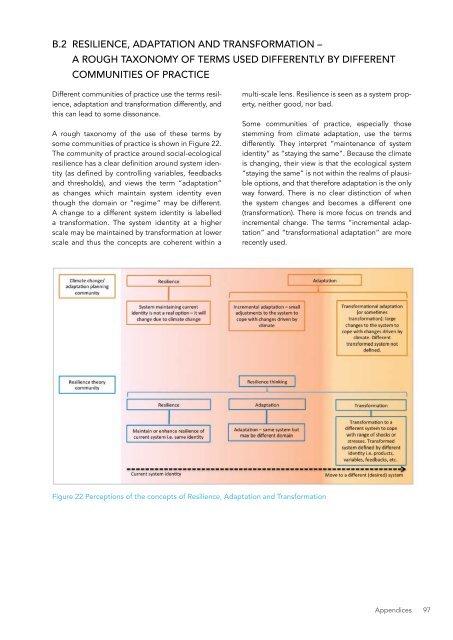DESIGNING PROJECTS IN A RAPIDLY CHANGING WORLD
srun3013fp1
srun3013fp1
You also want an ePaper? Increase the reach of your titles
YUMPU automatically turns print PDFs into web optimized ePapers that Google loves.
B.2 RESILIENCE, ADAPTATION AND TRANSFORMATION –<br />
A ROUGH TAXONOMY OF TERMS USED DIFFERENTLY BY DIFFERENT<br />
COMMUNITIES OF PRACTICE<br />
Different communities of practice use the terms resilience,<br />
adaptation and transformation differently, and<br />
this can lead to some dissonance.<br />
A rough taxonomy of the use of these terms by<br />
some communities of practice is shown in Figure 22.<br />
The community of practice around social-ecological<br />
resilience has a clear definition around system identity<br />
(as defined by controlling variables, feedbacks<br />
and thresholds), and views the term “adaptation”<br />
as changes which maintain system identity even<br />
though the domain or “regime” may be different.<br />
A change to a different system identity is labelled<br />
a transformation. The system identity at a higher<br />
scale may be maintained by transformation at lower<br />
scale and thus the concepts are coherent within a<br />
multi-scale lens. Resilience is seen as a system property,<br />
neither good, nor bad.<br />
Some communities of practice, especially those<br />
stemming from climate adaptation, use the terms<br />
differently. They interpret “maintenance of system<br />
identity” as “staying the same”. Because the climate<br />
is changing, their view is that the ecological system<br />
“staying the same” is not within the realms of plausible<br />
options, and that therefore adaptation is the only<br />
way forward. There is no clear distinction of when<br />
the system changes and becomes a different one<br />
(transformation). There is more focus on trends and<br />
incremental change. The terms “incremental adaptation”<br />
and “transformational adaptation” are more<br />
recently used.<br />
Figure 22 Perceptions of the concepts of Resilience, Adaptation and Transformation<br />
Appendices 97


